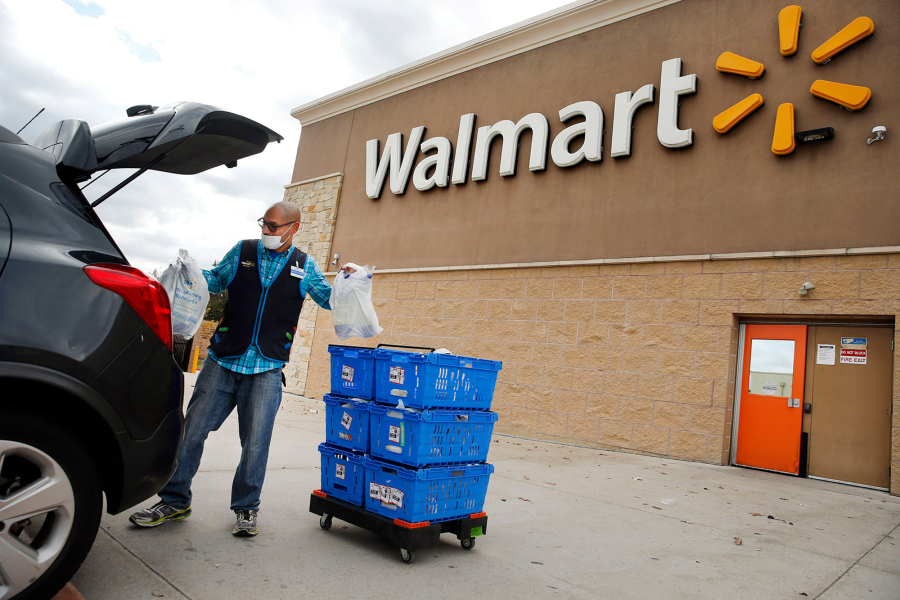Walmart holds a comfortable lead as the largest online U.S. grocer, according to the new national e-commerce forecast from Insider Intelligence, but there’s a fierce battle for No. 2 between Amazon and Instacart.
Walmart, which includes Sam’s Club and is also the largest U.S. and Dallas-Fort Worth grocer, surpassed Amazon’s grocery e-commerce business in 2019.
In 2022, Walmart will generate $38.72 billion in grocery e-commerce sales, representing 27.6% of the online grocery market. It will further increase its lead over Amazon and Instacart through 2024, said Blake Droesch, senior analyst at Insider Intelligence.
Instacart is running a tight race against Amazon which is expect will overtake Instacart next year to once again be No. 2, according to Insider Intelligence. Amazon’s online grocery business is expected to increase 16.5% to $29.49 billion this year, capturing 21.0% of the market. By the end of 2023, Amazon’s online grocery sales are expected to be $35.46 billion, compared with Instacart’s $35.19 billion.
“Since customers already associate the retailer with grocery, Walmart is poised to capture a large chunk of grocery dollars that flow from in-store to online,” Droesch said. “It’s also investing in its own fulfillment services, so it will be less reliant on Instacart and other delivery services going forward.”
Dallas-Fort Worth is getting a big share of the investments that grocery retailers are making in their online capabilities.
Walmart is spending $800 million on a new grocery fulfillment in Lancaster that will open in 2023 and will take pressure off its stores. Walmart said it will fill deliveries widely, throughout Texas and Oklahoma, from this facility.
Kroger just opened a new automated online grocery fulfillment center in southern Dallas. It’s already delivering groceries as far away as Austin and San Antonio and Oklahoma City through regional hubs fed by the Dallas facility.
H-E-B’s new Plano store opening this fall will have an area carved out of the store that will fill online grocery deliveries throughout D-FW. In a nationwide online grocery preference survey, H-E-B had a higher score than Amazon.
Instacart is expanding its curbside fulfillment partnerships with grocers across the U.S. In D-FW, Tom Thumb and Albertsons is working with Instacart and so is Kroger.
D-FW was one of the first markets where Target added curbside grocery and reconfigured interior store space to accomodate groceries that need to stay cold. Target also added smaller fulfillment centers here.
Online grocery sales are estimated to be $140.2 billion this year, or 9.9% of total grocery sales. It will be the first time online groceries represent 10% of the total pie.
And online grocery sales are forecast to grow at more than 10% annually, according to Insider Intelligence, so the battle is more than incremental dollars for U.S. grocers. Digital grocery sales are expected to reach 15% of the huge total grocery market by 2026.
Sliced a different way, U.S. grocery e-commerce sales will represent a 13.3% share of total U.S. online sales.
Inflation is fueling the strong growth in overall U.S. grocery e-commerce sales. The growth comes as food-at-home prices rose 13.1% year-over-year in July 2022, which is the largest 12-month increase since March 1979, according to the U.S. Bureau of Labor Statistics.
“Inflation is the main contributor to digital grocery sales growth this year,” said Droesch. “But long-term sales growth will be sustained by current digital grocery buyers spending more of their overall grocery dollars online.”
Why is Amazon pushing hard into grocery?
“Grocery has become a battleground for many of the top players in e-commerce,” Droesch said. “Food and beverage, as well as health and personal care, are among the fastest-growing categories in e-commerce, so these companies are depending on grocery to drive growth.”



